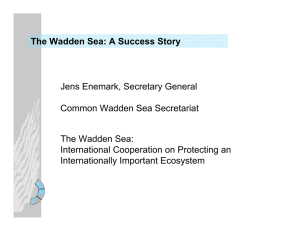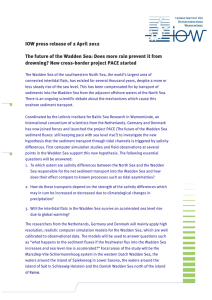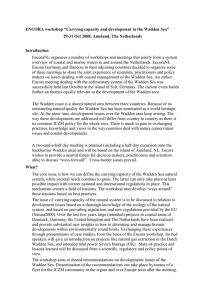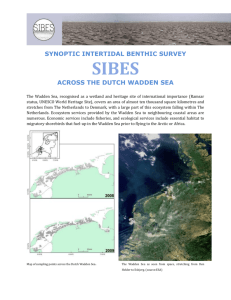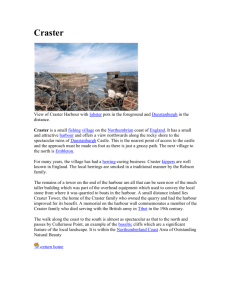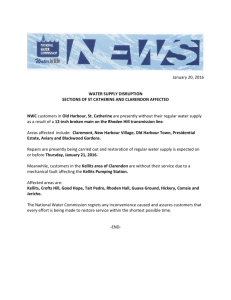. 0/ Population development of harbour seals in the Wadden Sea after... 1988 virusepizootie
advertisement
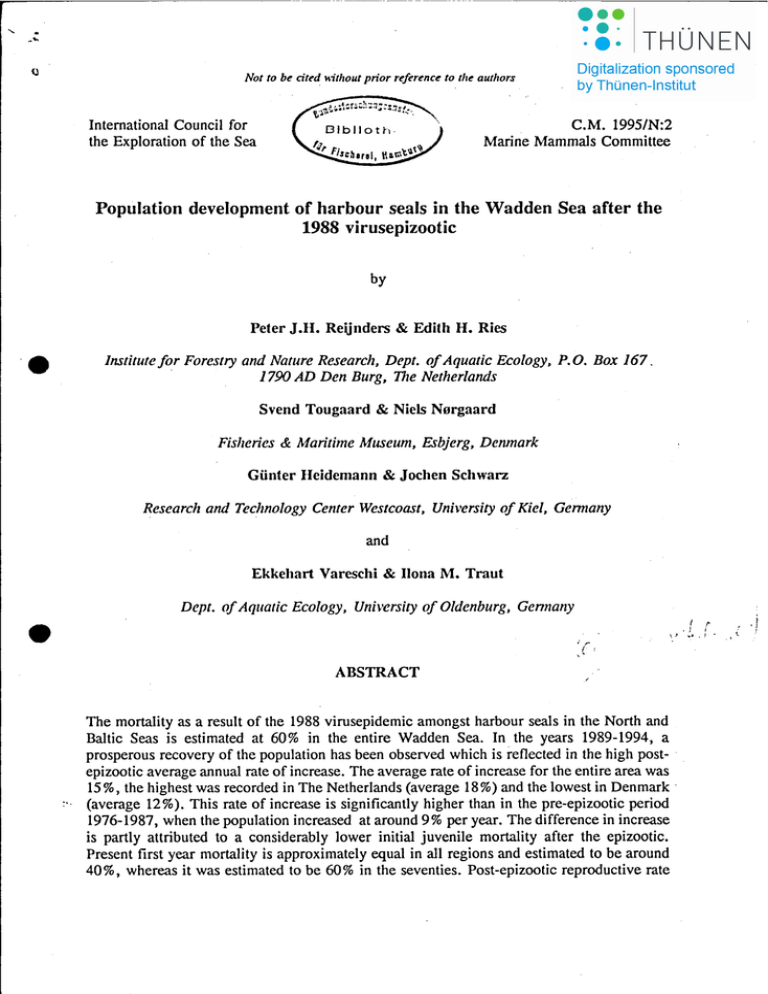
.
-"
Not to be dted without prior reference to the authors
International Council for
the Exploration of the Sea
C.M. 1995/N:2
Marine Mammals Committee
Population development of harbour seals in the Wadden Sea after the
1988 virusepizootie
by
Peter J.H. Reijnders & Edith H. Ries
Institute/or Forestry and Nature Research. Dept. 0/ Aquatic Ecology. P.O. Box 167.
.
1790 AD Den Burg. The Netherlands
Svend Tougaard & Niels Norgaard
Fislzeries & Maritime Museum. Esbjerg. Denmark
Günter Heidemann & Jochen Schwarz
Research and TecJmology Center Westcoast. University 0/ Kiel. Gennany
and
Ekkehart Vareschi &
•
110113
M. Traut
Dept. 0/ Aquatic Ecology. University o/Oldenburg. Gennany
I
\'
ABSTRACT
The mortality as a result of the 1988 virusepidemic amongst harbour seals in the North and
Baltie Seas is estimated at 60% in the entire Wadden Sea. In the years 1989-1994, a
prosperous recovery of the population has been observed which is retlected in the high postepizootic average annual rate of increase. The average rate of increase for the entire area was
15%, the highest was recorded in The Netherlands (average 18%) and the lowest in Denmark .
(average 12 %). This rate of increase is significantly higher than in the pre-epizootie period
1976-1987, when the population increased at around 9% per year. The difference in increase
is partly attributed to a considerably lower initial juvenile mortality after the epizootie.
Present first year mortality is approximately equal in all regions and estimated to be around
40%, whereas it was estimated to be 60% in the seventies. Post-epizootie reproduetive rate
I
f'
.,I ,i
~
!
,.
~
a
in The Netherlands is significantly higher (respectively 20% on average coinpared to 12-14% .
before 1988, it is somewhat higher in Niedersachsen (20 respeciively 16%), slightly lower
in Schleswig-Holstein (23 respcctively 20%), whereas it did not change in Denmark (average
17%). It is hypothesised that the improved reproductive rate in The Netherlands might be a
result of selective mortality during the epidemic, which· affecting within the adult female
.
segment predominantly those that did nor reproduce. .
It is emphasised that though the population is recovering weIl, its present size (almost 9000
animals in 1994) is still only one quarter of the estimated reference figure. Whether the
recovery will continue' at its present rate, will depend on environmentaI conditions in the
area, such as pollution and disturbance. Furthermore an eventual recurrent flickering of the
epidemie can not be excluded.
.
.
INTRonUCTION
The harbour seal population in the Wadden Sea can be regarded as a discrete population,
with insignificant exchange with other North Sea or Baltic stocks. The different
subpopulations have been drastically depleted in the past as a result of overhunting (Reijnders
1992). After hunting was stopped in the last area in the Wadden Sea in 1976, the population
recovered elearly (Reijnders er al. 1990). However, as a consequence of a virusepidemie in
1988, this recovery was interrupted and the population is assumed to be reduced by
approximately 60% (Schwarz & Heidemann 1994). In order to provide favourable eonditions
for a successful recovery ofthe Wadden Sea population, it was planned to design a long term
eonservation and management plan (CWSS 1992). The development of that plan and
implementation of related studies required elose cooperation between the countries involved,
and a comprehensive 5-years research plan was drafted. Through these studies it became
clear that in the years after the epizootie the population recovercd prosperously as was
reflected in the high post-epizootie rate of increase. This paper discusses the population
development and the course of the parameters population size, reproductive rate and initial
juvenile mortality, for the entire population as weIl as for the different subpopulations.
METHons
survCJs
The basic data for the analyses in this paper originate from census results obtained during
aerial surveys carried out in the period between 1989 and 1994. TraditionaIly, each of the
countries bordering the \Vadden Sea carricd out these surveys in their own region, namely
Denmark, Schleswig-Holstein, Niedersachsen and The Netherlands. For this project the
survey flights were synchronised and designed to cover all the haul-out sites within each of
the regions under, as far as possible, similar tidal stages within one flight Usually 8-10
flights per year have been carricd out in each region. The main data were collected during
the pupping season, therefore four to five flights were performed between June and July to
obtain the pupping curve (Reijnders 1978). Information on the distribution and number of
harbour seals in the Wadden Sea was also collected during these flights, but additional flights
proved indispensable to complete the information on animaIS hauled-out during the moult
(August).
' ,
Surveys were carried out simultaneously in all regions, preferably when low-tide occurred
2
•
•
1
around mid-day, and weather conditions were suitable. Notwithstanding, in some cases
conditionswere such that in a region alternative days had to be found.
data processing
maximum nllmber 0/ seals
., ..
For each region the maximum number of seals counted was used as a minimum estimate for
a specific year as it can be expected that some individuals are not hauled out and thus missed
during the survey. The annual figure for the minimum estimate ofthe harbour seal population
in the entire Wadden Sea, was derived from the sum of the minimum estimates of the
regions.
reprodllc/ive ra/es
Accordingly, the reproductive rate for the separate regions is expressed as the percentage of
the maximum number of pups observed per maximum total number of seals observed. For .
the entire Wadden Sea, the respective maximum numbers of pups are added and expressed
as apercentage of the summed maxima for each region.
initial juvenile monaliry
•
A method to estimate initial juvenile mortality in harbour seals is described in detail in
Fransz & Reijnders (1978) and in Fransz (1979). In their recruitment model, the time from
the first pup reported to the moment the maximum number of pups was observed (Wand
the totaJ. length of the whelping period (Ir) were used to providc a first estimate of the
juvenile mortality (M). Around this first estimate aseries of different values for 1\1 were tried
in the model to generate a curve with the best fit to the field data. It is emphasised that after
approximately four weeks of age the pups are weaned and do not haul-out as frequently as
during the lactation period. Furthermore, after about 4-5 weeks of age it becomes gradually
difficult to distinguish pups from yearlings and therefore this age group was not counted
separately any more. After six weeks of age, many pups leave the breeding area and might
haul-out less frequently than before. Due to these factors, juvenile mortality could be
overestimated if the basic model was run for aperiod extending four weeks after the start
of the whelping season. The model was therefore modified, taking into account the potential
bias in' relating pups observed, to survival of pups. However, it becomes gradually
complicated to quantify the possible error introduced and therefore the model was generally
applied only for at most 7 weeks after the start of the whelping season. The observations on
the abundance of pups in the course of the whelping season, carried out in the different
regions of the '\Vadden Sea during 1989-1994, formed the basic material used in the
recruitment model. Data for the entire Wadden Sea were obtained by using the pup-curves
for each region. At a given Julian day, thc number for each region was taken from the
respective curve and added to provide the sumo The length of the whelping period for the
entire Wadden Sea, was obtained by the ending date of the last starting whelping period in
a region and that was compared with the date of the region where the whelping period started
first.
RESULTS
population dcvclopmcnt
During the study period, from 1989 to 1994, a total of 237 aerial surveys were carried out
3
J ;.
in the different regions of the Wadden Sea.
.
The annual maximum number of harbour seals eounted in the Wadden Sea are shown in
figure 1. The sum of the different regions indicates a minimum estimate of the aetual size
of the harbour seal population in the Wadden Sea. It is evident that the total numbers·
observed inereased substantially since 1989. By 1994, a total of almost 9000 animals were
reported, more than twice the number observed in 1989. The annual instantaneous rate of
increase was on average 15%. The highest rate was observed among the stock in The
Netherlands (18%), and the Iowest in Denmark (12%).
10000 ~---::":~:--1'------------------_
TOTAL
NL
NS
SH
8000-
DK
•
6000-
4000-
~
.
2000 -
_._"
_0_'-;",-;;-;-,";-; ';;~"7 ~ -;.........
---:-------
_'_'-'-'-'_._'_._'-.~"~
..~~-;;:-""T
_._0
.
_._.-.;-.. :;'.-;~ .•••• """""
.
_--------1
-------------- ------
- - --
o-,...----~----~----~----~---_..
1989
Fi~ure
1990
1991
1992
1993
1994
1: AnllUal maximum numbers of harbour seals registered in thc different regions of thc Wadden
5ea.
reproductive rates
The reproductive rates, expressed as the ratio of the maximum numbers of pups eounted per
maximum number of seals (including pups) counted, are given for the different regions and
the .vhole area in figure 2. Aside from the year 1988 where in some regions the epidemie
had a direct effect on numbers born, the figures are approximately equal in all regions and
fluctuate around 20%. The figures for Denmark are somewhat lower than in other regions.
initial juvenile mortality
For different reasons, logistics and inc1ement weather conditions, not aIl the surveys in each
of the different regions provided each year adequate results to reliably run the recruitment
model. Therefore it is decided to use, as an example, the best data set for each region for
one given year. Those are: The Netherlands - 1993, Niedersachsen - 1992, Sehleswig4
•
Holstein - 1994, Denmark - 1993.
These are complemented by data for the total Wadden Sea in the years 1993 and 1994. The
results are shown in figure 3. The corresponding data on length of the whelping period,
relative mortality and initial juvenile mortality are given in Table 1.
I
NL
••
•
20
••
Ns
~
•
20
•
.0
SR
~
•
DK
~
••
•
20
TOTAL
V-
••
•
1991
'989
1M1
v.....
'''3
.....
Figure 2: Percentage of pups from maximum numbers of harbour seals (including pups) in the different
regions of the Wadden Sea.
•
Table 1. Length of whelping period (I,); rel. mortality rates (M); initial juvenile mortality in the
first seven weeks after the start of whelping (EM); in different years for the seal stocks in different
regions and for the population in the entire area.
I
Area, year
I,
11
(days)
I
M
(day·l)
I
EM
(%)
NL 1993
37
0.022
33
NS 1992
35
0.024
36
SH 1994
37
0.020
31
DK 1993
34
0.024
37
Wadden Sea 1993
44
0.020
34
Wadden Sea 1994
44
0.020
34
5
I
DISCUSSION
population dcvclopmcnt
During the study period the maximum number of harbour seals observed in the Wadden Sea
more than doubled, from initially 4400 in 1989 to 8882 in 1994. The annual instantaneous
rate ofincrease was on average 15%. The highest rate was observed among the stock in The
Netherlands (18%), and the lowest in Denmark, where it was 12%.
After the virus epidemie in 1988, which affected all European harbour seal populations,
different annual rates of increase were observed: Heide-Jorgensen er al. 1992 reported in the
Skagerrak I Kattegat ea. 8 % and in the Wash the population increased only bya few percent
annually.
Among the harbour seal population of the Wadden Sea, such a high rate of increase was not
observed before. After a similarly low population status during the late 1970's, the entire
population increased only at 9% per year, despite full protection from hunting (Reijnders er
ale 1990). This increase was different in the several subpopulations, 12 % in Denamrk
(Tougaard 1989, Bogebjerg er ale 1991), 8% in Schleswig-Holstein, 7% in Niedersachsen
and 8 % in The Netherlands.
rcproductivc rates
Before the epidemie substantial differences in reproductive rates were persistent among the
different areas of the Wadden Sea, ranging from 12% in The Netherlands to 22% in
Schleswig-Holstein. In recent years pup percentages are more close.
Especially in The Netherlands the reproductive rate is significantly higher than before. This
holds, but to a lesser extent, also for Niedersachsen. An explanation might be that a selective
mortality oceurred during the epidemie. The data eollected by the project participants on
animals found dead during the epizootie, do for most regions not indicate a sex-specifie
mOrtality besides for Denamrk where 65% of all dead seals were males. Apart from a high
mOrtality of the yearelass 1988, neither an agegroup-specifie mortality is assumed as e.g.
illustrated by Schwarz & Heidemann (1994). However, that does not preclude the possibility
that amongst the adult females, the animals which died were predominantly those not
reproducing due to impairment by pollution (Reijnders 1986). During the harbour seal
epizootie in the North Sea, high mortalities were observed in the colonies in which pollutant .
levels were higher (Hall er al. 1992, Simmonds er ale 1993). Given these findings and the
fact that pup production was too low in The Netherlands and in Niedersachsen and pupping
and lactation are considered an important route to excrete contaminant residue levels, it is
postulated that the epidemie might have been selective for nonbreeding adult females. This
is supported by the observation that also an absolute improvement of pup production
oecurred. Even if the size of the largely killed yearclass 1988 is taken into account, more
pups are born with the same number of animals in the post-epizootie years compared with
the pre-epizootie periode
As the first yearclass was almost totally lost during the epidemie, the improved reproductive
rate could be partly of an arithmetical nature since the denominator in the division is smaller
than before. However, that contribution can only be marginal. Before the epidemic, the 1
year old animals would constitute 9-10% of the population and that missing compartment
only brings pup production up by < 2%. The pup percentages are expected to level off
within a fcw years becausc of gradual changcs in thc population structure, in particular an
6
•
•
------------------
increase in the proportion of immature animals. When these ageclasses enter the reproductive
segment of the population, pup percentages might either increase or decrease further,
depending on the levels exposure of these animals to environmental pollutants causing
reproductive failure.
•
initial juvenile mortality
The simulation model is based on the assumption that the births are normally distributed over
the whelping season. The data points on the right side of the curves (the end of the whelping
season) fit less accurately the curves than the data points in the left side (the beginning of the
whelping season). This is due to the stronger influence of mortality and furthermore there
is a larger possibility to underestimate the number of pups due to changes in haul-out
behaviour and dispersal during the second part of the whelping period. However, the fit is
considered good enough to conclude that the distribution of births is in agreement with the
provision to follow a Gaussian frequency distribution. The recruitment curves are based on:
1) the assumption about normal distribution of whelping; 2) a limited set of available data
points; 3) estimates for the length of the reproduction period.
Although the method is not particularly sensitive to small changes in the these parameters,
it is emphasized that the outcome should be used tentatively.
Total Wadden Sea
(%)
[N)
100
•
-
1\
•
....
/
\
•\
•
1993
'.
'
\
0
•
100
•
of\
•
•
0
190
"'-
[
•
•
.
Z46
0
JullaD day
20
40
60
1994
80
100
Days
Figure 3: Number of pups counted during the aerial surveys (left hand diagrams) and recruitment curves
based on the recruitment model calculations (right hand diagrams). Fulllille = llumber of pups born;
dotted line = number of survivillg pups; dashed lille observable number of pups; * aerial survey data.
7
..
[N]
[%]
100
r\.,. ,.
•••
..
••
•
\
•
\
0
NL
1993
,
\
100
••
..
~'"\
••
•
•
•
•
•
NS
,,
~
1992
'.
\
""
0
•
100
•
SR
1994
•
••
•
0
100
..
~
• ••
.I
•
,.,
DK
\.
\
\
0
134
190
Juliao day
244
0
ZO
40
1993
'.
~
60
Days
80
100
Figure 3: continued.
It appears that there is little variation in the mortality rates between the different areas as
weH as between each of the areas and the total Wadden Sea. On average, the initial juvenile
mortality - up to 7 weeks after the start of the whelping season - amounts to approximately
8
•
..'
•
•
34%. Given an unknown additional mortaIity during the rest of their first year, compared
with data from other harbour seal populations presumably around 7%, it is assumed that the
first year mortality in the harbour seal population in the Wadden Sea is around 40%
nowadays. Drescher (1979) and Reijnders (1978) estimated first year mortality in the 1970s .
to be 55-60%. Dreschers calculations were not based on the recruitment model and he found
a post-breeding first year mortality of around 20%. If the data from the 1970s are applied .
in the revised model, the initial juvenile mortaIity does not diverge from the present one.
However, when the 20% post-breeding mOrtality is added, the overall first year mortaIity in
the 1970s amounts to 55%. This does concur with Dreschers independently obtairied figure.
Reijnders (1978) probably underestimated post-breeding mortality. This implies that the
present post-epizootie first year mortality is considerably lower compared with the 1970s.
However, it is still higher than in other harbour seal populations. For the Swedish westcoast,
Härkönen (1987) assumes 30-35%, Bigg (1969) quotes 25% for ßritish Columbia arid ßoulva
(1973) reports 25% for Sable Island (east Canada). It is possible that disturbance might
contribute to the comparatively high mortality among harbour seals in the Wadden Sea .
(Drescher 1979; Reijnders er al. 1981; Vogel 1994; ßrasseur & Reijnders 1994).
prospects
It is emphasized that the population is recovering weIl, however its present size ( nearly 9000
in 1994) is still only one quarter of the estimated reference figure (Reijnders 1992). Whether
it will continue to recover at its present rate will depend on the pressure of environmental
conditions, such as pollution and disturbance, whilst an eventual reeurrent flickering of the
epidemie can not be excluded either.
REFERENCES
B1GG, M.A. 1969. The harbour seal in british Columbia. Fish. Res. Dd. Can. Dull. 172.
DOULVA, J. 1973. Tbe harbour seal (Phoca vitulina concolor) in eastem Canada. Dalhousie Univ., Nat. Lib. Ottawa,
Canada: 1-134 (thcsis).
DOGEDJERG, E., S. TOUGAARD, J. MADSEN & N. NORGAARD 1991. Status ofthe harbour seal Phoca ~'ilu/ina in
the Danish watcrs, 1976-1989, and short tcrm cffeets of the epidemie in 1988. Dan. Rev. Game Dio!. 14: 1·16.
•
DRASSEUR, S.M.J.M. & P.J.II. REIJNDERS, 1994. Invlocd van diverse vcrstoringsbronncn op het gcdrag en
habitatgebruik: van gewone zeehonden: conscquenties voor de inrichting van hel gcbicd. IBN·rapport 113.
COMMON WADDEN SEA SECRETARIAT, 1992. Sixth trilateral Govemmental Wadden Sea Conference, 1991.
Ministerial Deelaration - Seal Conservation and Managemcnt Plan - Memorandum of Intcnd - Assessment Rcport.
Wllhe1mshavcn. pp. 55.
DRESCHER, H.E. 1979. Biologie, Ökologie und Schutz dcr Seehunde im schlcswig-holstcinischen Wattenmeer.
Deitr. Wildbio!. Meldorf 1. 73 p.
FRANSZ, II.G. 1979. Estimation of birth rate and juvcnile mortality from obscrvcd numbcrs of juvenilcs in a mammal
population with normally dispcrscd rcproduction. Ecol. Model. 7: 125-133.
FRANSZ, H.G. & P.J.H. REIJNDERS 1978. Estimation of birth rate and juvcnile mortality from obscrvcd numbcrs of
juvcniles in a seal population with normally dispcrsed reproduction. ICES C.M 1978/n:7.
HÄRKÖNEN, T. 1987. Fceding eeology and population dynamics of the harbour seal (Phoca vitulina) in KattcgatSkagerrak. Thcsis Univ. Götcborg, Swcdcn.
9
..
~
HALL, A., R.J. LAWS, D.E. WELLS, J. HARWOOD, H. ROSS, S. KENNEDY, C.R. ALLCHIN, L.A. CAMPBELL
& P.P. POMEROY 1992. Organochlorine levels in common seals (Phoca vitulina) which were victims and
survivors of the 1988 distemper epizootie. Sei. tot. Environm. 115: 145-162.
HEIDE-J0RGENSEN, M.P., T. HÄRKÖNEN & P. ABERG 1992. Long-term effects ofepizootie in harbor seals in the
Kattegat-Skagerrak and adjacent areas. Ambio 21: 511-516.
REIJNDERS, P.l.H. 1978. Recruitment in the harbour seal (Phoca vitulina) population in the Duteh Wadden Sea. Neth.
1. Sea Res. 12: 164-179.
REIJNDERS, P.l.H. 1986. Reproduetive failure in e{)mmon seals feeding on fish from pollutOO eoastal waters. Nature 324:
456-457.
REIJNDERS, P.J.H., H.E. DRESCHER,l.L. VAN HAAFTEN, E. B0GEBJERG HANSEN & S. TOUGAARD 1981.
Population dynamics of the harbour seal in the Wadden Sea. In: P.l.H. REIJNDERS & W.l. WOLFF (OOs),
Marine mammals of the Wadden Sea. BaIkema, Rotterdam; 19-32.
REIJNDERS, P.J.H., E.H. RIES & I.M. TRAUT 1990. Robbenbestiinde. In: J.L. Lozan, W. Lenz, E. Raehor, B.
Watermann & H. v. Westernhagen (OOs), Warnsignale aus der Nordsee. Paul Parey, Berlin; 320-324.
REIJNDERS, P.l.H. 1992. Retrospeetive population analysis and relatOO future management perspeetives for the harbour
seal Phoca vitulina in the Wadden Sea. Neth. Inst. Sea Res. Spee. Pub!. Ser.20:193-197.
SIMMONDS, M., P. JOHNSTON & M.C. FRENCH 1993. Organochlorine and mercury contamination in UK seals. Veto
Rec. 20: 291-295.
•
SCHWARZ, J. & G. HEIDEMANN 1994. Zum Status der Bestände der Seehund- und Kegelrobbenpopulationen im
Wattenmeer. In: 1.L. Lozan, E. Raehor, K. Reise, H. V. Westernhagen & W. Lenz (OOs); Warnsignale aus dem
Wattenmeer. Blackwell Wissensehaftsverlag, GmbH, Berlin; 296-303.
TOUGAARD, S. 1989. Monitoring the seal (Phoea vitulina) in the Danish Wadden Sea. Helgo!. Meeresunters. 43: 347356.
VOGEL, S. 1994. Ausmaß und Auswirkungen von Störungen auf Seehunde. In J.L. Lozan,E. Raehor, K. Reise, H. V.
Westernhagen & W. Lenz (OOs); Warnsignale aus dem Wattenmeer. Blaekwell Wissenschaftsverlag, GmbH,
Berlin; 303-308.
•
10
~twn
la e:
Mit der Bitte wn:
Original
o Stelltmgnahme
Kopien
o Kenntnisnahme
o Erledigung •
o Rücksprache
stellschein
lette
{RÜCkgabe
0 Verbleib
)( Ansicht
o Verteiltmg
0 bei Nichtinteresse zurück
o weiterleitung an:

